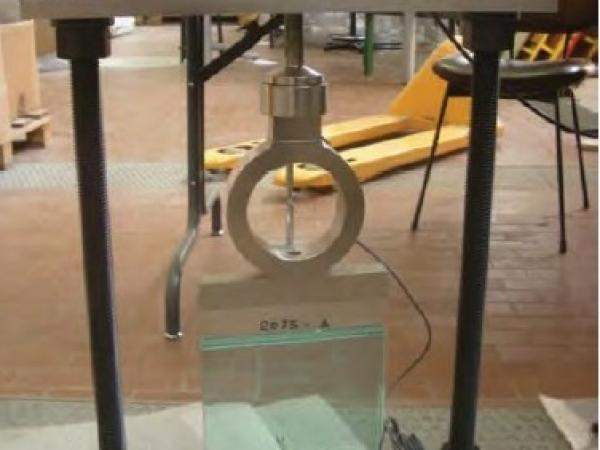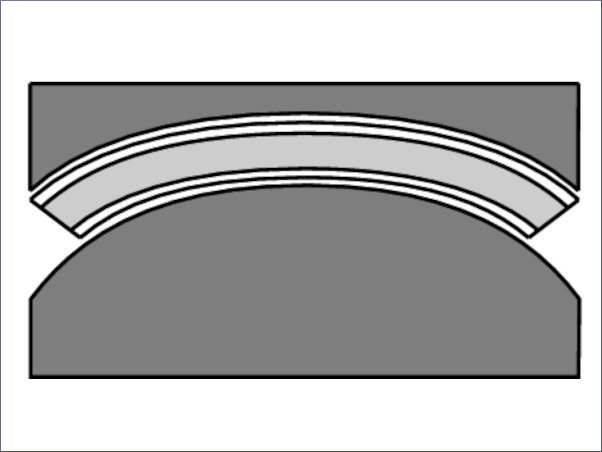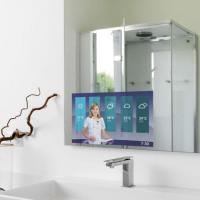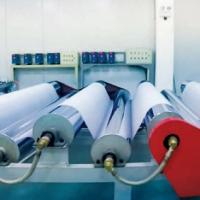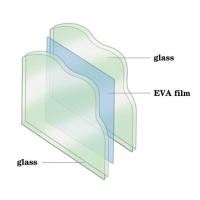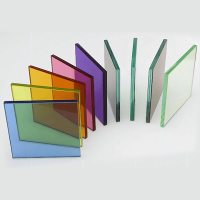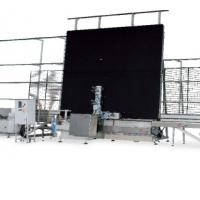Furthermore, the presence of plastic interlayers gives to LGs a residual load carrying capacity after glass cracking [1]. The specimens used in the experimental campaign were laminated using polyvinyl-butyral (PVB), which is the most widely used interlayer material [2].
Introduction
Laminated glasses (LG) consist of two or more glass sheets bonded together with plastic interlayers. The lamination gives to LGs a safer behaviour than monolithic glasses, avoiding injuries to people in case of breakage. Furthermore, the presence of plastic interlayers gives to LGs a residual load carrying capacity after glass cracking [1]. The specimens used in the experimental campaign were laminated using polyvinyl-butyral (PVB), which is the most widely used interlayer material [2].
.jpg)
Click to enlarge. - Figure 1 - Frontal and lateral view of specimens
PVB deeply infl uence the mechanical behaviour of laminates, as it is very sensible to loading duration and temperature change [3]. In particular the viscosity of PVB allows for signifi cant relative displacements between two adjacent glass plies under long-term loads (e.g. self-weight) and/or high temperatures (e.g. façade or roofi ng applications), as it has been already shown in other researches [4], [5]. In the present study, the authors performed tests under very long-term loads (till about 41 days), varying temperature and relative humidity.
Concerning the effects of humidity, other researchers have demonstrated how the adhesion of PVB to glass is infl uenced by the PVB storage humidity before the lamination process [6]. Differently, the present research investigated the infl uence of ambient humidity on PVB viscoelastic properties in already assembled LG units.
Test setup
Push-out tests were performed on LG specimens made with three glass plies. Nine sets of specimens, with different geometrical dimensions, were arranged; each set consists of three specimens (identifi ed by capital letters A, B, and C) (Figure 1 and Table 1).
.jpg)
Click to enlarge.
The specimens were tested under different temperature and humidity conditions, which were chosen similar to those typical of façades. Tests were performed in a climatic chamber to maintain a constant temperature and humidity.

Figure 2 - Test setup (out of the climatic chamber)
Also the load was selected to simulate a real case application in a façade, i.e. the load was chosen to induce at PVB-glass interface shear stresses between 0.33 N/mm2 and 0.65 N/mm2. The load was applied by means of a dynamometric ring and was manually adjusted by means of a screw (see Figure 2).
At higher temperatures shear stresses in PVB relax very quickly and the load should be adjusted frequently. Unfortunately, frequent load regulations were not possible because they would have required too frequent openings of the climatic chamber, which would have changed test climatic conditions. For this reason, the test at 50 °C was performed with decreasing load steps at regular time intervals (see Figure 3).
Tests were arranged for six different climatic conditions, which are listed in Table 2. During tests, the applied load and relative displacements between the central glass sheet and the outer sheets were automatically recorded.
Experimental results
The diagrams in Figure 3 ÷ 8 show load and displacement variations against time. For each series only the results of a representative specimen are shown.
.jpg)
Click to enlarge.
.jpg)
Figure 3 - Climatic cond. 1, specimen 2050-A
.jpg)
Figure 4 - Climatic cond. 2, specimen 2125-B
.jpg)
Figure 5 - Climatic cond. 4, specimen 2050-C
.jpg)
Figure 6 - Climatic cond. 5, specimen 2200-A
.jpg)
Figure 7 - Climatic cond. 5, specimen 2350-B
.jpg)
Figure 8 - Climatic cond. 6, specimen 2350-C
The variation in time of the effective shear modulus G(t) was evaluated by:
G(t) = V(t)/Aγ(t) (1)
where V(t) = Q(t)/2 is the shear force, Q(t) is the load applied to the specimen (almost constant), A = B·D is the adhesion surface of PVB, B and D are the dimensions of the overlapping area of the specimen (see Figure 1), γ(t) = δ(t)/s is the shear deformation, δ(t) is the relative displacement between internal and external glass plates, s = 1,52mm is the nominal thickness of PVB interlayer.
The diagrams in Fig. 9 ÷ 13 represent the variation of the effective shear modulus G against time. Again for each series only the results of a representative specimen are shown. The fi rst series (50 °C, 70 % RH) is not represented as it was not possible to maintain a constant load.

Figure 9 - Climatic cond. 2, specimen 2125-B
.jpg)
Figure 10 - Climatic cond. 3, specimen 2050-C
.jpg)
Figure 11 - Climatic cond. 4, specimen 2200-A
.jpg)
Figure 12 - Climatic cond. 5, specimen 2350-B
.jpg)
Figure 13 - Climatic cond. 6, specimen 2350-C
Performed tests show that PVB creep effects continue to grow even for many days after the load application. In particular, at higher and intermediate temperatures displacements increase without approaching a constant value (Figures 3 ÷ 6). On the other hand, at the lowest temperatures (-20 °C) the PVB behaves similarly to an elastic material (Figures 7 and 8), as it is confi rmed by the analysis of G(t) variation (there is no signifi cant variation along 5∙105 s, ~ six days, see Figure 13).
The effective modulus is about 0.2 N/mm2 at 50 °C and 30 °C for short duration loads (1 min); for the same time duration, at 20 °C G is equal to 0.67 N/mm2.
On the other hand, at lower temperatures (-6.5 °C and -20 °C) G is greater than 4.0 N/mm2. Differently, for long-time intervals (till the end of tests) the value of G is less than 0.005 N/mm2 at 50 °C and greater than 3.0 N/mm2 at -20 °C. These results confi rm data obtained if one uses the time-temperature superposition principle [7, 8, 9].
After load removal, PVB does not return to the initial undeformed confi guration, even after many days (Figures 4 ÷ 6), probably due to a permanent plastic deformation in the material.
The variation of the relative humidity seems not to have infl uence on the shear modulus (see Figure 10 and Figure 11). Comparing data at 20 °C for short-term loads (1 min), the effective shear modulus is 0.77 N/mm2 at 50 % HR and 0.57 N/mm2 at 90 % HR. Differences become negligible for longterm loads (about 1 month). More tests are required to confi rm these observations.
The aspect ratio of specimens seems to have some influence at intermediate temperatures (20 °C and 30 °C), especially for short duration loads, while differences become negligible for long-time durations.More data are required to accurately evaluate the influence of specimen aspect ratio.
Concluding remarks
The experimental campaign confi rms the sensitivity of PVB to temperature. For long-term loads, the value of the effective shear modulus could be neglected for temperatures higher than 20 °C. On the other hand, at lower temperatures (-6.5 °C and -20 °C) the G value is greater than 3.0 N/mm2, even after many days from load application (tests at -6.5 °C had a duration of 23 days).
The influence of relative humidity and aspect ratio of specimens require to be investigated more deeply by extending the experimental campaign in order to have the required data for a statistical analysis.
Aknowledgments
The authors gratefully acknowledge funding from the Italian Ministry of Education, University and Research (MIUR), Prof. Giampaolo Rosati for the test setup development and Eng. Veronica F. Fumagalli for help in data recording and analysis.
References
[1] A. Kott and T. Vogel, Remaining StructuralCapacity of Broken Laminated Safety Glass, Proceedings of GPD - Glass Processing Days, Tampere (Finland), 2003.
[2] J. Wurm, Glass Structures. Design and Construction of Self-Supporting Skin, Birkhäuser, 2007.
[3] P. D’Haene, Structural Glazing - Creep Deformation of PVB in Architectural Applications, Proceedings of GPD - Glass Processing Days, Tampere, (Finland), 2001, pp. 357-362.
[4] V. Sackmann, C. Schuler, and H. Gräf, Testing of Laminated Safety Glass, Proceedings of ISAAG - International Symposium on the Application of Architectural Glass, Munich (Germany), 2004.
[5] E. Cagnacci, R. Foconi, M. Orlando, and P. Spinelli, Numerical Simulation and Experimental Analysis of PVB Interlayers, Proceeding of XXV A.T.I.V. International Conference, Parma (Italy), 2010, pp. 34-38.
[6] M. Froli and L. Lani, Adhesion, Creep and Relaxation Properties of PVB in Laminated Safety Glass, Proceedings of GPD 2011- Glass Performance Days, Tampere, (Finland), 2011.
[7] J. D. Ferry, Viscoelastic properties of polymers, Wiley, New York, (1980).
[8] A. Van Duser, A. Jagota, and S. J. Bennison, Analysis of Glass/Polyvinyl Butyral Laminates Subjected to Uniform Pressure, Journal of Engineering Mechanics, Vol. 125, No. 4, (1999), 435–442.
[9] P. D’Haene and G. Savineau, Mechanical properties of laminated safety glass - FEM Study, Proceedings of GPD2007 - Glass Performance Day, Tampere (Finland), June 15th-18th, (2007).
Authors
Luigi Biolzi
Politecnico di Milano, Italy
Emanuele Cagnacci, Maurizio Orlando, Lorenzo Ruggero Piscitelli
Università degli Studi di Firenze, Italy


